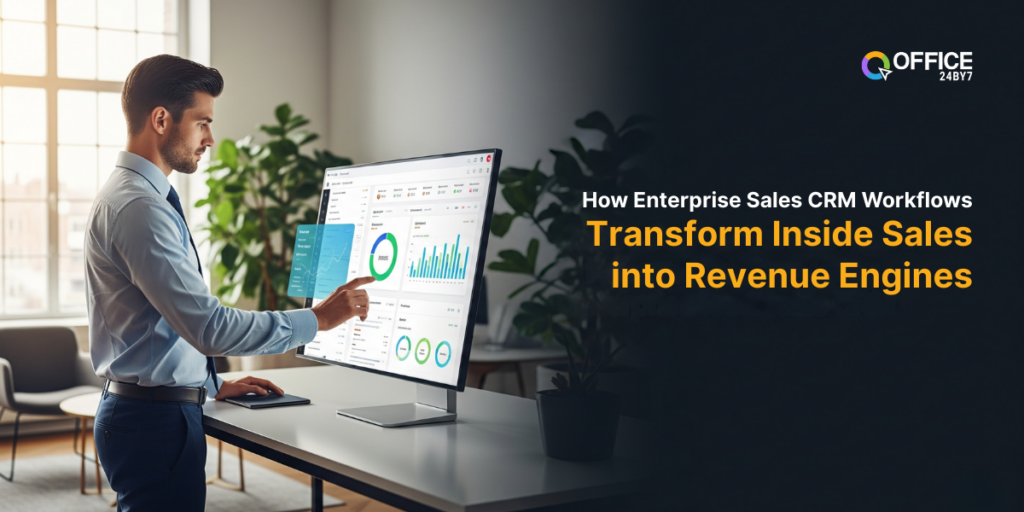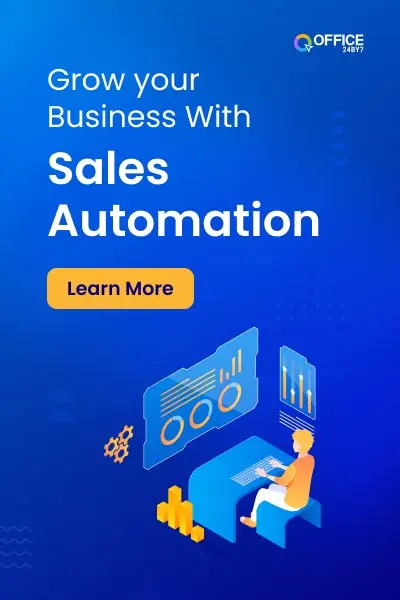
Not sure if this blog on Sales CRM contains quality information?
Try our 1-minute short audio summary to decide. 🎧
Inside sales teams today face relentless pressure. They must be able to make sales faster, expand their coverage, and produce regular income every quarter. Spreadsheets, inboxes, and standalone calling systems are not up to the task of meeting these demands without the right Sales CRM.
For large enterprises, the challenge only multiplies. Complexity mounts, leads fall through the cracks, and forecasting becomes guessing. The thing that is lacking, therefore, is structure, a system that automates, guides, and connects all the aspects of the sales process.
This blog explores how enterprise-grade Sales CRM workflows provide that structure, turning fragmented processes into reliable revenue engines.
The Challenge of Scaling Inside Sales Without Enterprise Sales CRM
Fragmented systems might work for a small team. At the enterprise level, however, they soon crumble under pressure. As a result, manual processes create backlogs, managers lose track, and sales cycles stretch longer than they should.
The biggest problem? Consequently, agents end up wasting more time handling tools than in selling. Without integration, such as cloud telephony software and a unified Sales CRM, even routine customer interactions slow down, turning an operational challenge into a direct revenue leak.
Bottlenecks in Lead Management
Leads are the lifeblood of sales. Yet in most organizations, they’re managed poorly.
In most organizations, teams manage leads poorly. Without centralized workflows, leads remain unassigned, sit untouched for days, or receive duplicate follow-ups from multiple agents. Every delay and duplication lowers the likelihood of a conversion.
At enterprise scale, this becomes unmanageable. Automated routing in a Sales CRM will fix this immediately, ensuring the right lead goes to the right agent in real time.
Data Silos and Inconsistent Processes
Data is also scattered across different tools. One system tracks calls, another stores emails, and spreadsheets hold reports. In the end, managers then struggle to piece everything together, yet the picture remains incomplete.
For sales agents, this inconsistency creates chaos. Every customer interaction feels disconnected. Agents have no idea what happens next when there is no single process.
An Omnichannel Marketing, ready CRM addresses this by collating all touchpoints, voice, email, SMS, and chat into a single location. The outcome: consistency, accountability, and a better view of what is working.
Limited Forecasting and Revenue Predictability
Forecasting is supposed to give leaders confidence. When data is in silos, there are errors in forecasts.
Manual updates mean managers work with outdated information. Pipelines look inflated. Deals that should have closed weeks earlier stay marked as open, leading to missed targets and weak resource planning.
With an enterprise Sales CRM, forecasting becomes data-driven. Real-time dashboards and automated reporting help leaders trust the numbers, make wiser investments, and predict revenue with confidence.
How Enterprise CRM Workflows Redefine Inside Sales
Enterprise CRM workflows don’t just replace old systems. They reshape the way sales teams operate. By automating and adding intelligence to everyday processes, they eliminate waste and align the whole team with revenue targets.
Streamlined Lead Capture and Distribution Using CRM
Speed matters. Prospects who show high interest convert faster, which makes immediate engagement critical. Workflows capture leads instantly and route them to the right agent. A unified Sales CRM aids in this process.
Workflows make sure that leads are captured immediately and directed to the appropriate agent. No manual assignments. No confusion. Just faster follow-ups and more closures.
This not only boosts productivity but also improves the overall buying experience. Customers feel attended to, not lost in the shuffle.
Automated Follow-Ups and Engagement Pattern in Sales CRM
Follow-ups often make or break a deal. But most agents find this hard to keep up with when they have dozens of leads. The system will remind you of a call, email, or meeting by using predefined workflows. Engagement happens on time, every time. Agents can focus on conversations instead of calendars.
This consistency improves conversion rates dramatically. Sales teams can enhance these workflows with features like click-to-call service or voice broadcasting, reaching many prospects at once without losing a personal touch.
Centralized Task and Activity Management in Sales CRM
Managers need visibility to drive performance. Sales CRM workflows automatically track every call, email, meeting, and task, ensuring nothing gets overlooked.
Leaders can be able to monitor closely how things are going, identify areas where things are taking too long, and ensure that all team members are taking responsibility for their tasks. For agents, it reduces admin work. For managers, it provides transparency. And to the business, it means everyone is on the same page regarding the same objectives.
Advanced Analytics for Smarter Sales CRM Decisions
Workflows feed directly into analytics. Agents do not have to update spreadsheets manually. Leaders will have dashboards that indicate the health of the pipeline, the velocity of the deals, and bottlenecks that are starting to arise.
This transforms decision-making. No more guessing. No more waiting for monthly reports. Just accurate, up-to-date insights that fuel smarter strategies.
Feel the power of a CRM Software!

Driving Predictable Revenue Through Enterprise Sales CRM Workflows
Revenue predictability is not a matter of luck; it is the result of stable processes. By enforcing consistent processes, sales CRM workflows strengthen inside sales performance and directly improve core business metrics.
Reducing Sales Cycle Length with Sales CRM
Delayed follow-ups or approvals drain momentum, but automated workflows prevent such slowdowns. As a result, deals close faster and revenue gets recorded quickly. Automated workflows fix this. Reminders trigger instantly. Approvals move faster. Prospects get timely responses.
The consequence is that deals are closed faster and revenue is booked quickly.
To companies pursuing quarterly goals, a few days off the cycle can mean a fortune in terms of money.
Increasing Conversion Rates Across the Funnel Using CRM
Every lead costs money to generate. Losing them to poor follow-up is wasteful for any enterprise.
CRM workflows enforce consistent engagement. No lead is ignored. No opportunity is forgotten. This discipline turns more leads into paying customers.
It is not only the question of volume but also the matter of the highest ROI on every dollar invested in marketing. For instance, apps such as missed call service tracking and virtual number routing will capture and convert all opportunities.
CFO and Leadership Lens: ROI of Inside Sales Transformation with Sales CRM
To CFOs, the question is not just whether this works. It’s “Does this pay off?”
This is why executives of the enterprise must understand Sales CRM workflows as a financial plan and not as a technological update. In platforms like the Office24by7 Sales CRM, workflows align sales activities with financial outcomes, ensuring measurable results.
Linking CRM Workflows to CAC and CLTV
CAC drops when processes are efficient. Automated workflows eliminate idle efforts, reduce response times, and maintain healthy pipelines.
At the same time, cross-channel customer interaction increases CLTV. Moreover, the customer will always remain in contact even after the first purchase with tools like a ticketing management system, and therefore will remain a loyal customer.
Scaling Revenue Without Linear Cost Growth in CRM
The real power of enterprise CRM is scalability. Office24by7 Sales CRM enables teams to work with more leads without the need to increase headcount. Automation takes care of the routine jobs, and analytics assists in the smart allocation of resources.
This means that growth need not be associated with an equivalent rise in costs. Productivity goes up. Margins improve. CFOs are getting what they desire: higher returns but without unruly costs.
Conclusion
Inside sales has always been about numbers. But without structure, those numbers don’t add up. Enterprise Sales CRM workflows correct inefficiencies, introduce consistency, and enable sales teams to work to their best potential.
Office24by7 not only gets workflows that scale but also provides access to a platform that can adapt to their business needs. Ultimately, faster sales cycles, higher conversions, and forecasting that is predictable turn inside sales into a predictable and powerful revenue-driving machine.
This is the time to act by CFOs and decision-makers. They can stop looking at CRM as a software cost, but as a long-term financial strategy.
Explore how the Sales CRM workflows of Office24by7 can become the basis of sustainable sales transformation. Call us at +91-7097171717 or email sales@office24by7.com and begin to transform your inside sales team into a true revenue engine now.



